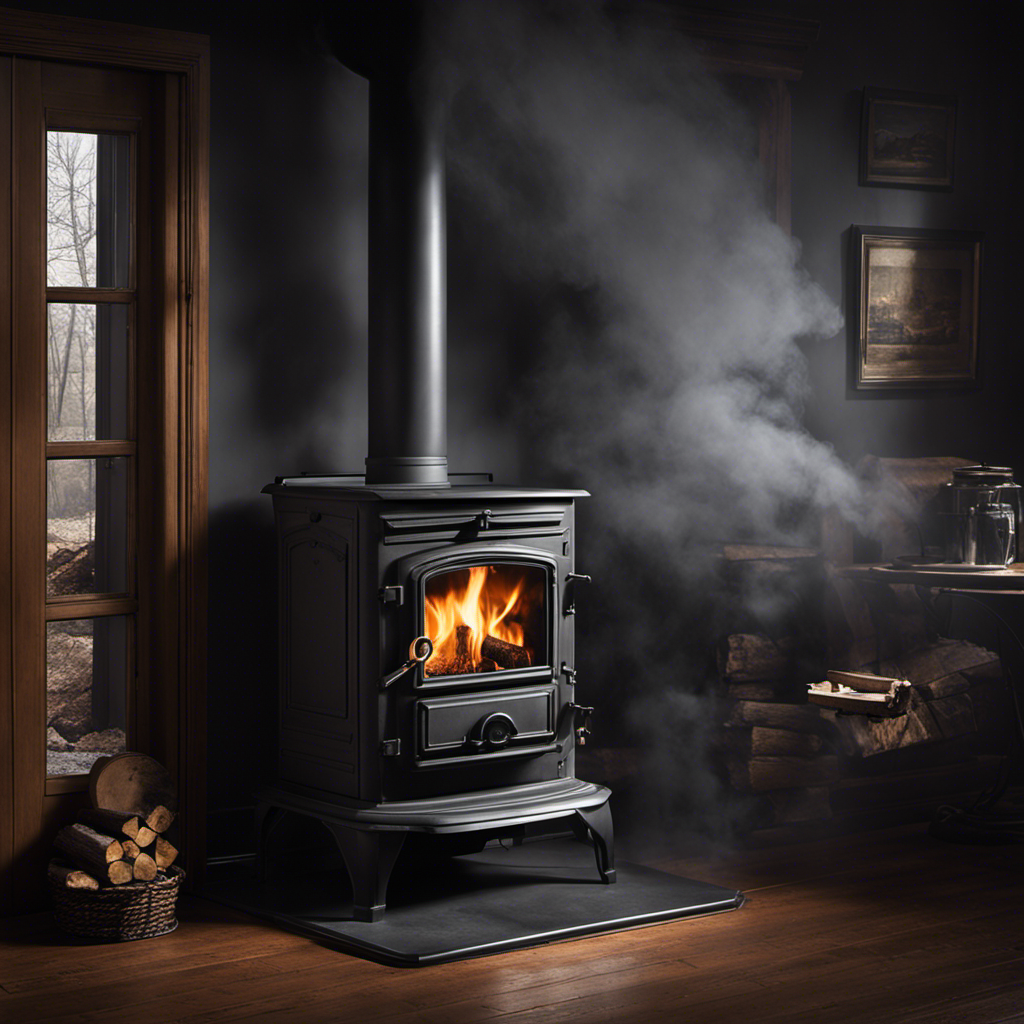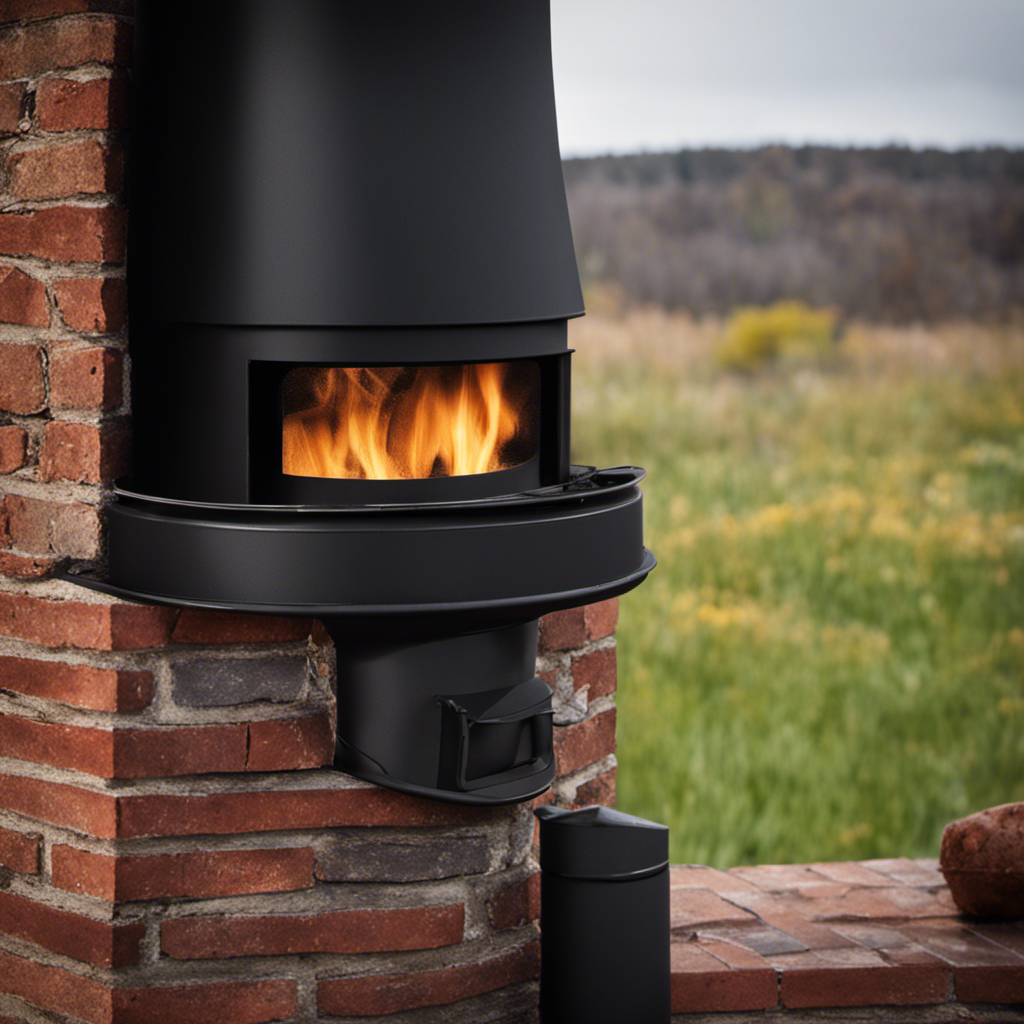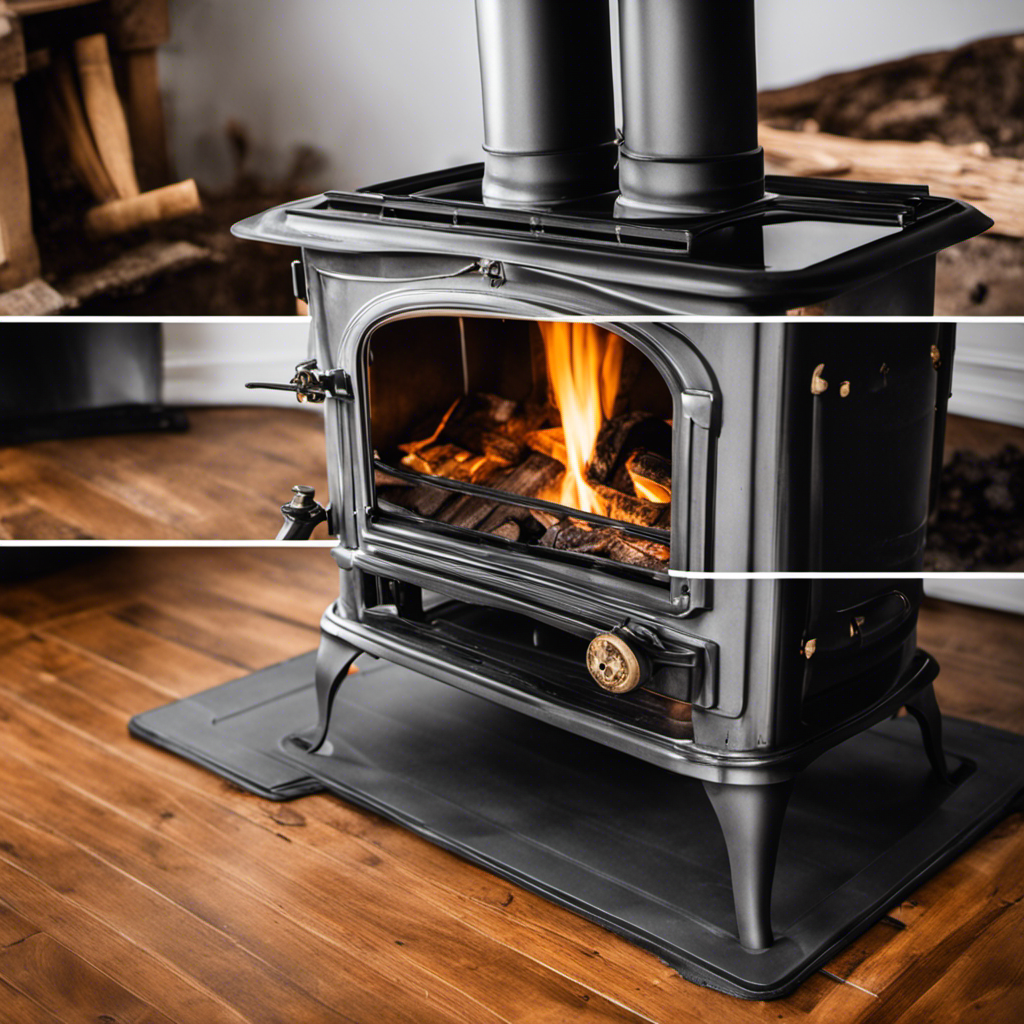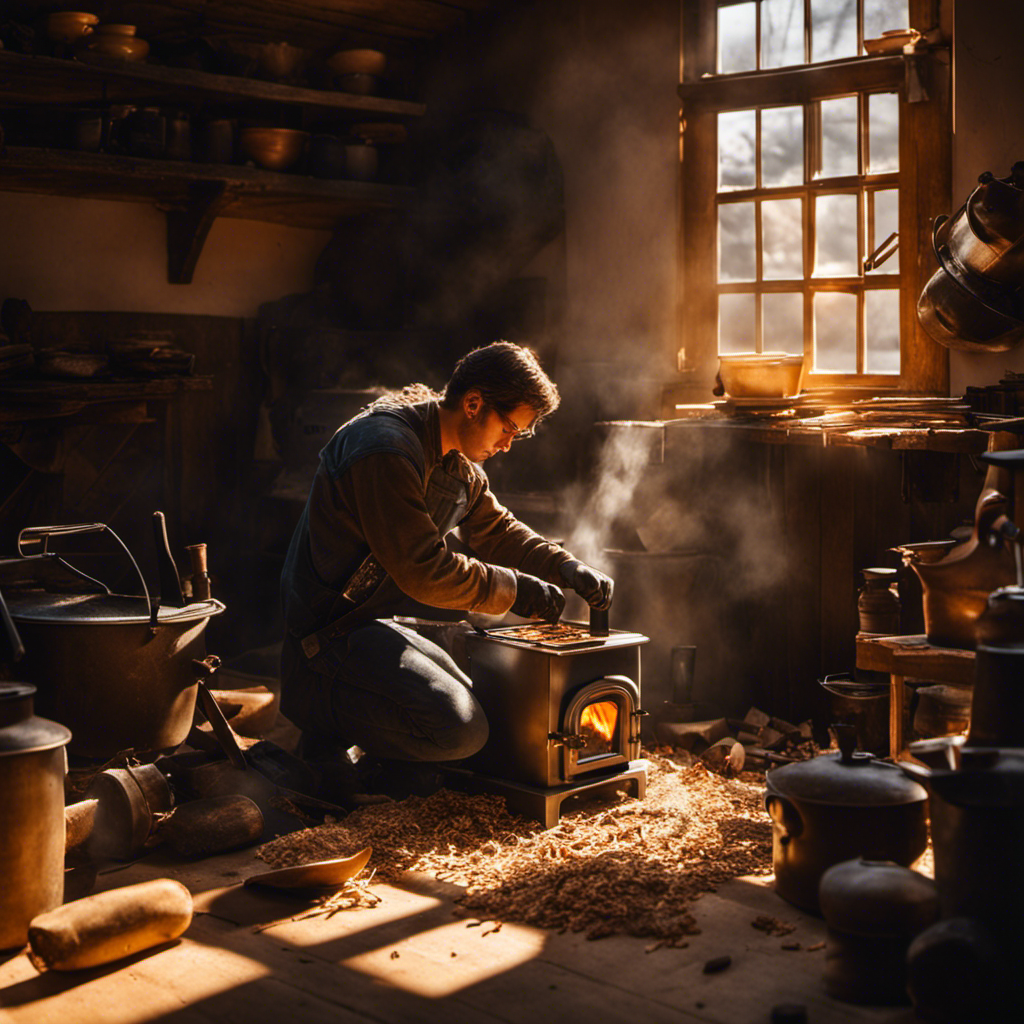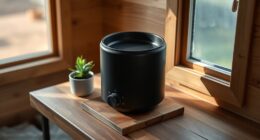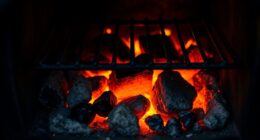Have you ever encountered the situation where you open the door to your wood stove and immediately find yourself surrounded by a cloud of smoke? This is not just a minor inconvenience; it points to a significant issue.
In this article, I’ll explore the various reasons why your wood stove might be smoking when the door is open. From insufficient draft to damaged chimneys, we’ll cover it all.
So grab a seat and let’s unravel this smoky mystery together.
Key Takeaways
- Insufficient draft and inadequate insulation can cause smoke to enter the living space when the wood stove door is open.
- Proper venting and insulation are essential to prevent smoke from escaping into the room.
- Regular maintenance and cleaning of the chimney are crucial to prevent blockages and smoke-related issues.
- Using dry, quality fuel and maintaining proper airflow control are important for efficient wood stove operation and reducing smoke production.
Insufficient Draft
I think I’m experiencing insufficient draft, as the smoke from my wood stove isn’t being properly vented out when I open the door. Ventilation issues can occur due to various factors, including inadequate insulation.
Insufficient draft refers to a situation where the flow of air into and out of the wood stove isn’t optimal, leading to smoke buildup inside the stove. This can be caused by a lack of proper air supply or inadequate insulation around the stovepipe.
Inadequate insulation can result in heat loss and a decrease in the temperature difference between the inside and outside of the stove, affecting the natural draft. To address this issue, it’s important to ensure proper insulation and maintain a clear and unobstructed stovepipe to allow for efficient ventilation and prevent smoke from entering the living space.
Incorrect Installation
The wood stove may smoke due to incorrect installation or a lack of proper ventilation. Improper venting and inadequate insulation can both contribute to this issue. Improper venting occurs when the stovepipe is not installed at the correct angle or when it is not connected properly to the chimney. This can cause the smoke to back up into the room instead of being directed outside. Inadequate insulation can lead to a buildup of creosote, a highly flammable substance that can block the chimney and prevent proper airflow. This can cause the smoke to escape into the room instead of being expelled through the chimney. To prevent these issues, it is essential to ensure that the wood stove is installed correctly, with proper venting and insulation.
| Improper Venting | Inadequate Insulation |
|---|---|
| – Stovepipe not installed correctly | – Buildup of creosote |
| – Improper connection to chimney | – Blockage of chimney |
| – Smoke backs up into the room | – Smoke escapes into the room |
Damaged or Blocked Chimney
There are several signs that indicate a damaged or blocked chimney, such as a strong odor, excessive smoke, or difficulty in starting a fire. To ensure the safe and efficient operation of your chimney, regular chimney maintenance is crucial.
Here are three important steps to take:
-
Inspection: Schedule an annual inspection by a professional chimney sweep to check for any damage or blockages. They’ll examine the chimney structure, flue liner, and chimney cap to ensure everything is in proper working condition.
-
Cleaning: Regular chimney cleaning is essential to remove creosote buildup, which can lead to chimney fires. A professional chimney sweep will use specialized tools and techniques to remove any debris or obstructions.
-
Smoke Detector Installation: Install smoke detectors near your wood stove and in every bedroom of your home. This will provide early detection of any potential smoke-related issues and ensure the safety of your household.
Poor Fuel Quality
Using poor quality fuel can cause the wood stove to produce excessive smoke and decrease its efficiency. One of the main factors contributing to this issue is the moisture content of the fuel. When the wood has a high moisture content, it takes longer to burn, resulting in incomplete combustion and the release of more smoke. Inadequate ventilation is another key factor that can lead to excessive smoke production. Insufficient airflow prevents the wood from burning at the optimal temperature, causing incomplete combustion and the generation of more smoke. To highlight the impact of moisture content and inadequate ventilation on smoke production, consider the following table:
| Factor | Effect on smoke production |
|---|---|
| High moisture content | Increased smoke |
| Inadequate ventilation | Increased smoke |
Understanding how poor fuel quality affects smoke production is crucial for maintaining the efficiency of a wood stove. However, another important aspect to consider is improper airflow control, which will be further discussed in the following section.
Improper Airflow Control
I can’t properly regulate the airflow in my wood stove, which is causing the smoke to be trapped inside. This issue is likely due to an inadequate ventilation system or a malfunctioning flue damper.
Here are three possible reasons for the improper airflow control:
-
Flue Damper Position: The flue damper controls the amount of air entering and exiting the stove. If the damper isn’t positioned correctly, it can restrict the airflow, leading to smoke buildup inside the stove.
-
Air Intake Control: Wood stoves typically have an air intake control that regulates the amount of oxygen entering the combustion chamber. If the air intake is closed too much, it can restrict the airflow and cause smoke to be trapped inside.
-
Blocked or Restricted Chimney: A blocked or restricted chimney can disrupt the natural draft and prevent smoke from exiting the stove. This can be caused by debris, bird nests, or creosote buildup.
To resolve this issue, it’s important to check and adjust the flue damper, ensure proper air intake control, and regularly clean and maintain the chimney to ensure proper ventilation.
Frequently Asked Questions
Can Using Wet or Green Wood Cause a Wood Stove to Smoke When the Door Is Open?
Using wet or green wood in a wood stove can cause smoke when the door is open. Wet wood produces more moisture and can result in incomplete combustion, while green wood contains more sap and moisture, leading to increased smoke production.
Are There Any Health Risks Associated With a Wood Stove That Smokes When the Door Is Open?
When a wood stove smokes with the door open, it can pose health risks due to poor ventilation. It’s important to address this issue promptly to ensure the safety of your indoor air quality.
Can a Wood Stove Smoke When the Door Is Open Due to a Malfunctioning Damper?
Yes, a wood stove can smoke when the door is open due to a malfunctioning damper. The damper controls the airflow, so if it is not functioning properly, it can cause smoke to escape into the room.
Is It Normal for a Wood Stove to Emit a Small Amount of Smoke When the Door Is Open?
When the door of a wood stove is open, it is not normal for it to emit smoke. This could be caused by improper ventilation or a malfunctioning damper. Regular cleaning and maintenance, as well as using seasoned firewood, can help prevent this issue.
Can a Wood Stove Smoke When the Door Is Open if the Stove Is Not Properly Sealed or Gasketed?
When the wood stove door is open, it’s not normal for it to smoke excessively. This could indicate a problem with the stove’s seal or gasket. Regular maintenance, like wood stove gasket replacement and door seal maintenance, can help prevent this issue.
Conclusion
In conclusion, it’s important to troubleshoot the possible causes of a wood stove smoking when the door is open.
Insufficient draft, incorrect installation, a damaged or blocked chimney, poor fuel quality, and improper airflow control can all contribute to this issue.
It’s crucial to address these issues promptly to ensure the safe and efficient operation of the wood stove.
Remember, identifying and fixing these problems is like untangling a knot, allowing the smoke to disperse smoothly.
Logan’s affair with adventure began in childhood. He hailed from a small town where vast forests bordered one side and endless shores stretched on the other. His days were spent exploring uncharted woods, climbing tall trees, or listening to the tales of old sailors. This early immersion in a world brimming with stories and mysteries became the foundation of his passion for writing.

